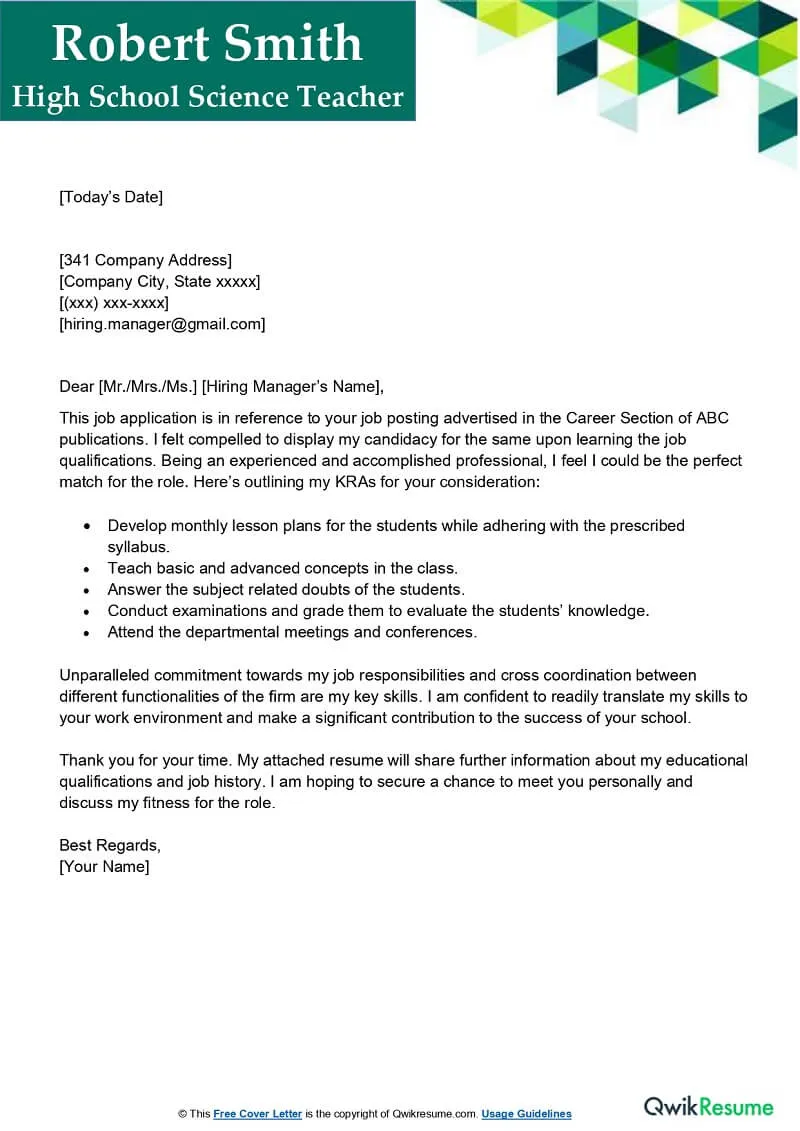Crafting a Compelling Cover Letter for Science Teachers
A well-crafted cover letter is your first chance to make a great impression and secure a science teaching position. It’s more than just a formality; it’s your opportunity to showcase your personality, experience, and passion for science education. A compelling cover letter grabs the attention of hiring managers and encourages them to delve deeper into your qualifications, ultimately leading to an interview. This guide will provide you with the essential tips and strategies to create a cover letter that stands out from the competition and helps you land your dream job as a science teacher.
Highlighting Your Science Teaching Experience
Begin by clearly stating your experience as a science teacher, including the grade levels you’ve taught and the subjects you’re proficient in. Detail specific teaching roles you’ve held, emphasizing responsibilities and achievements. Focus on relevant experience, even if it’s not directly in a teaching role, and connect this experience with the requirements of the job description. Show, don’t just tell; illustrate your skills through examples of successful lesson plans, projects, and classroom management strategies. For instance, describe how you’ve successfully incorporated innovative teaching methods or managed a diverse classroom environment. Remember, your goal is to demonstrate that you are well-prepared for the role.
Showcasing Your Curriculum Knowledge
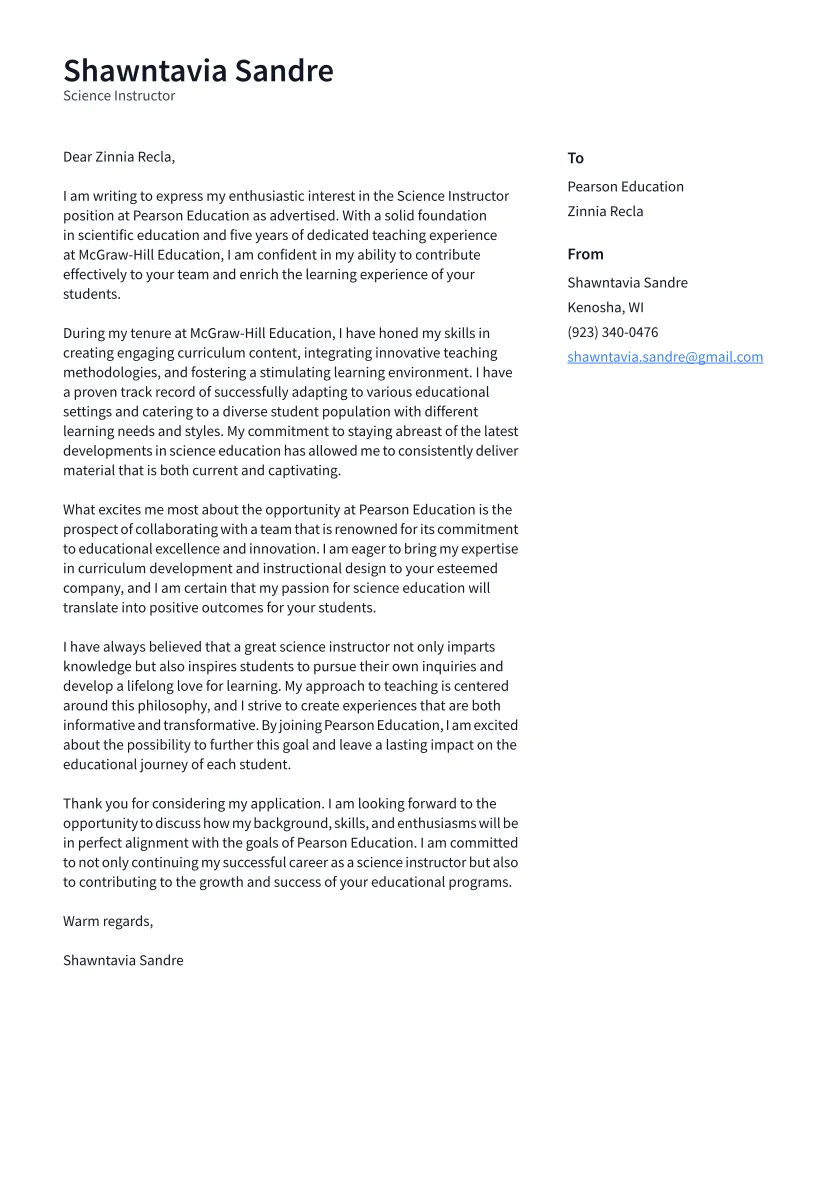
Demonstrate your curriculum knowledge and expertise in your cover letter. Highlight the specific science disciplines you’re most comfortable teaching, such as biology, chemistry, physics, or environmental science. Mention any curriculum development experience or familiarity with educational standards like Next Generation Science Standards (NGSS). Detail your ability to create engaging lesson plans, design lab activities, and assess student learning effectively. For instance, if you’ve developed and implemented a project-based learning unit, describe the learning objectives, activities, and outcomes. This showcases your understanding of curriculum design and your ability to bring science concepts to life for your students. Show the depth of your knowledge and how it translates to student success.
Quantifying Your Achievements
Use metrics to show your achievements and impact in the classroom. Quantify your accomplishments whenever possible, such as the percentage of students who improved their grades, the number of students who participated in science competitions, or the positive feedback you received from parents. For example, instead of saying “Improved student engagement,” you could say “Increased student engagement by 20% through hands-on lab activities.” Use numbers and data to support your claims, and provide concrete evidence of your ability to make a positive impact on student learning and school performance. Quantifiable achievements make your cover letter more persuasive and memorable.
Emphasizing Relevant Skills
Highlight skills that are most relevant to the science teacher position. Mention skills such as classroom management, lesson planning, assessment, differentiation, and use of technology in the classroom. Tailor your skills to match the job description. If the job posting emphasizes the need for collaboration, give examples of how you’ve worked with colleagues. If it highlights the importance of incorporating technology, showcase your skills with educational software or online learning platforms. This targeted approach will help the hiring manager understand how well you fit their requirements and make your application stand out.
Demonstrating Passion for Science Education
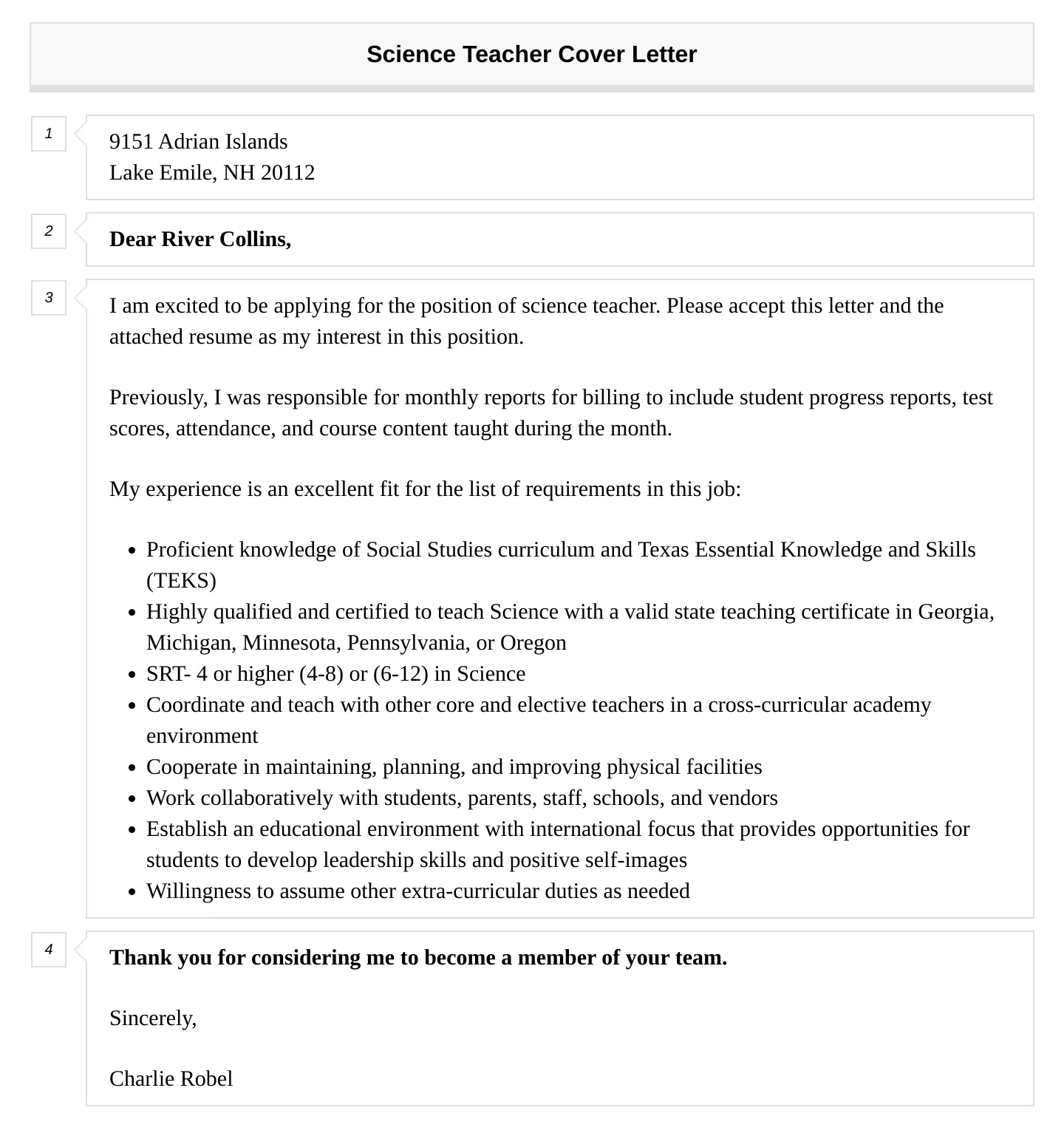
Convey your enthusiasm for science and education through your cover letter. Share what excites you about science, and what motivates you to teach. Discuss why you love helping students explore the world around them through scientific inquiry. Provide examples of how you have inspired students in the past, such as through science fairs, extracurricular activities, or mentoring programs. A passionate cover letter demonstrates your commitment to the profession, and shows the hiring manager that you are genuinely invested in student success. Make sure to let your personality shine through, showcasing your enthusiasm for science and teaching.
Tailoring Your Cover Letter to the Specific School
A generic cover letter will not impress a hiring manager. Take the time to tailor each cover letter to the specific school and position you’re applying for. This personalization shows that you’ve put in the effort to learn about the school and that you’re genuinely interested in the opportunity.
Researching the School and its Values
Research the school’s mission, values, and any specific initiatives or programs they offer. Look at their website, social media profiles, and any available information to get a sense of their culture and what they prioritize. If the school emphasizes STEM education, highlight your experience with STEM-related activities. If they are committed to diversity and inclusion, discuss your experience in creating inclusive learning environments. Demonstrate that you share their values and goals, and that you’re a good fit for their community. This demonstrates that you are serious about the opportunity.
Addressing the Hiring Manager Directly
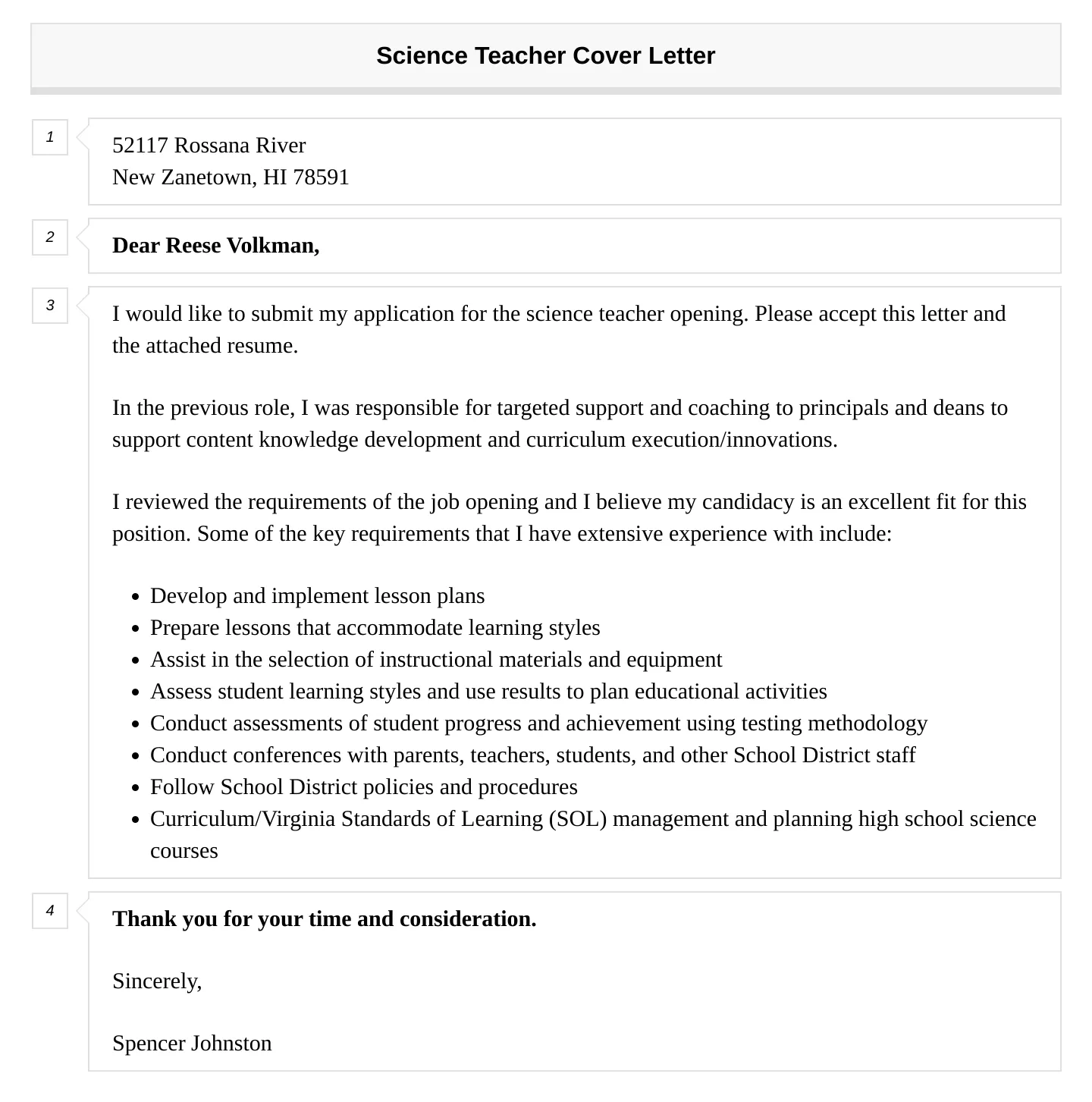
Whenever possible, address your cover letter to the hiring manager by name. This shows that you’ve done your research and that you’re taking a personal approach. If you can’t find a specific name, use a professional salutation like “Dear Hiring Committee.” This level of personalization demonstrates a higher level of effort and professionalism, which can make a difference in the hiring manager’s perception of your application. It demonstrates that you care enough to do your homework.
Using Keywords from the Job Description
Carefully review the job description and identify the key skills, qualifications, and requirements they’re seeking. Incorporate those keywords and phrases naturally throughout your cover letter. This helps your application get noticed by applicant tracking systems (ATS) and ensures that you’re highlighting the most relevant information for the hiring manager. However, avoid keyword stuffing; your cover letter should still read well and accurately reflect your qualifications. Use the keywords strategically to increase your chances of being noticed.
Structuring Your Cover Letter Effectively
A well-structured cover letter is easier to read and makes a positive impression. Clear organization is crucial for making your points effectively and keeping the reader engaged.
Opening with a Strong Hook
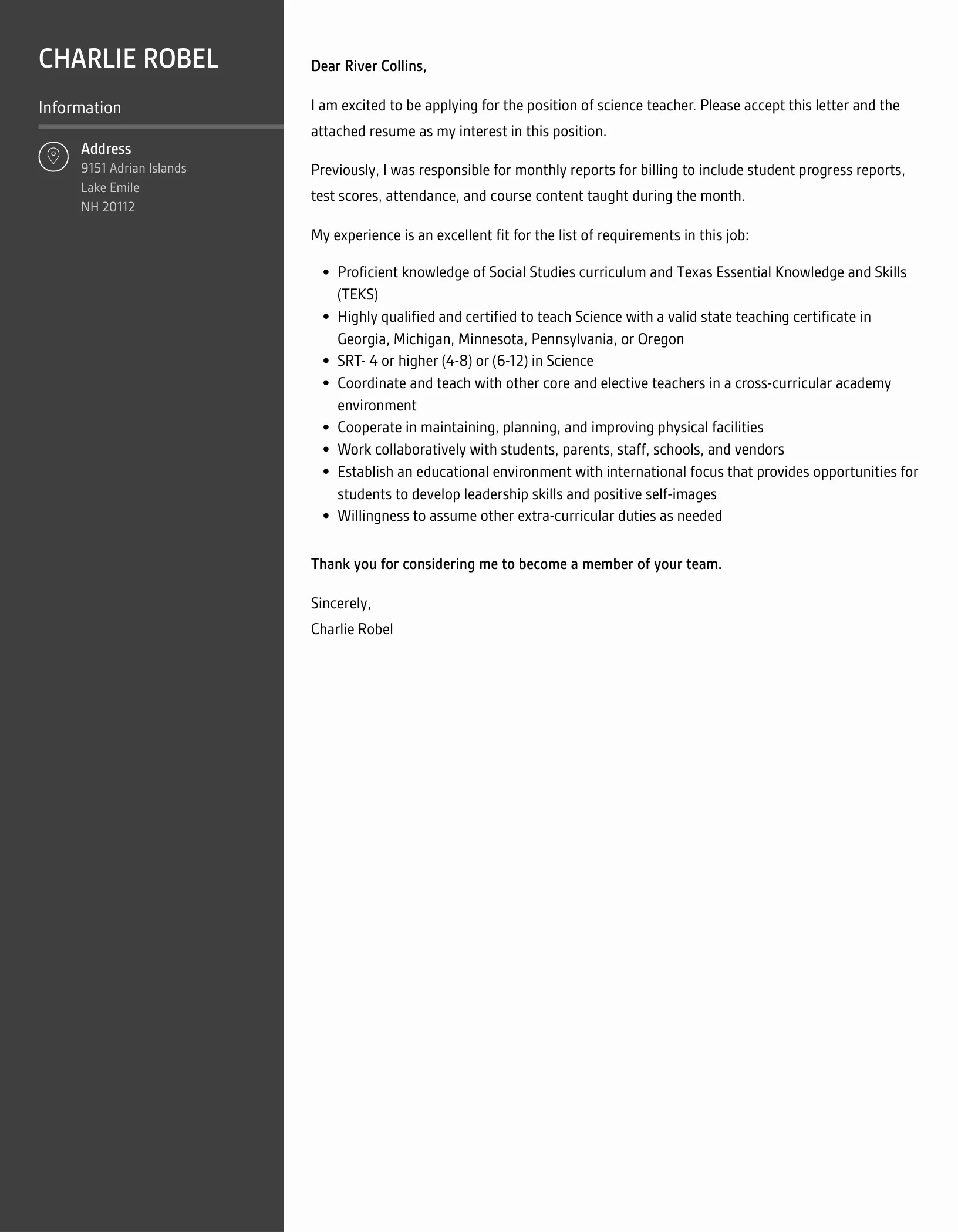
Your opening paragraph is critical; it sets the tone for the entire letter. Start with a compelling hook that immediately grabs the reader’s attention. State your interest in the position and the school, and briefly highlight your most relevant qualifications or accomplishments. Consider starting with a brief anecdote about your passion for science or an accomplishment that aligns with the job description. For example, you could describe a successful science project you led or a specific teaching strategy that yielded positive results. Make the opening memorable and show enthusiasm.
Structuring the Body Paragraphs
Use the body paragraphs to expand on your qualifications and experiences, providing specific examples to support your claims. Organize your body paragraphs logically, using each paragraph to address a different aspect of your qualifications. Use clear topic sentences to introduce each paragraph’s main idea. Provide concise, easy-to-read explanations, keeping the language clear and professional. Be sure to demonstrate how your skills and experiences align with the job description’s requirements. Use concise language to maintain the reader’s interest and focus on key points.
Concluding with a Call to Action
Your concluding paragraph should summarize your interest in the position and reiterate your key qualifications. Include a call to action, such as stating your availability for an interview and providing your contact information. Express your enthusiasm for the opportunity and thank the hiring manager for their time and consideration. A strong closing reinforces your interest and makes it easy for the hiring manager to take the next step.
Proofreading and Editing Your Cover Letter
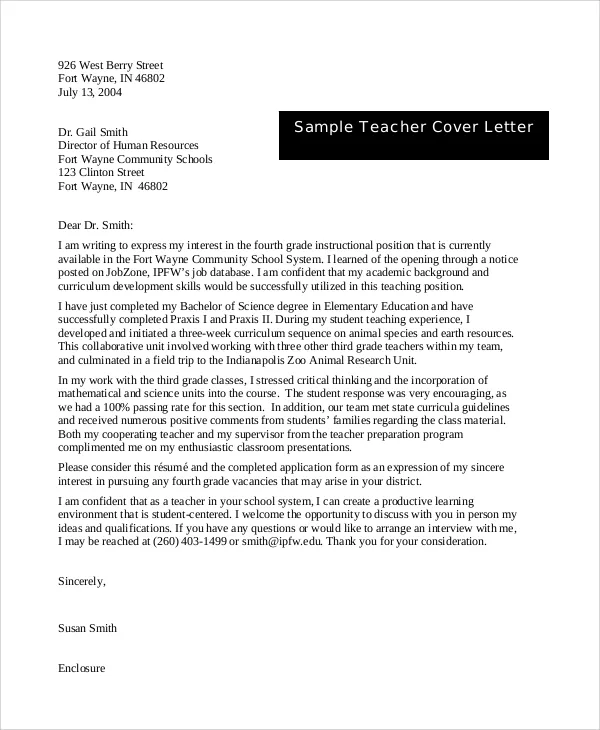
Before you submit your cover letter, carefully proofread and edit it. Errors in grammar or spelling can reflect poorly on your attention to detail.
Checking for Grammar and Spelling Errors
Thoroughly review your cover letter for grammar and spelling errors. Use a grammar checker and spell-check tool, but also read it carefully yourself, as these tools can sometimes miss errors. Ensure that your sentences are correctly structured, and the punctuation is correct. Correcting any errors is essential. Errors can undermine your credibility and make you seem less professional. If possible, have a friend or colleague review your cover letter.
Ensuring a Professional Tone
Maintain a professional tone throughout your cover letter. Avoid slang, jargon, or overly casual language. Use a formal salutation and closing. Be respectful and enthusiastic, but refrain from using overly informal or conversational language. Ensure the tone matches the school’s culture and the expectations of the hiring manager. Use language that is clear, concise, and professional, reflecting your dedication to teaching. Strive for a tone that demonstrates confidence and professionalism.
Formatting for Readability
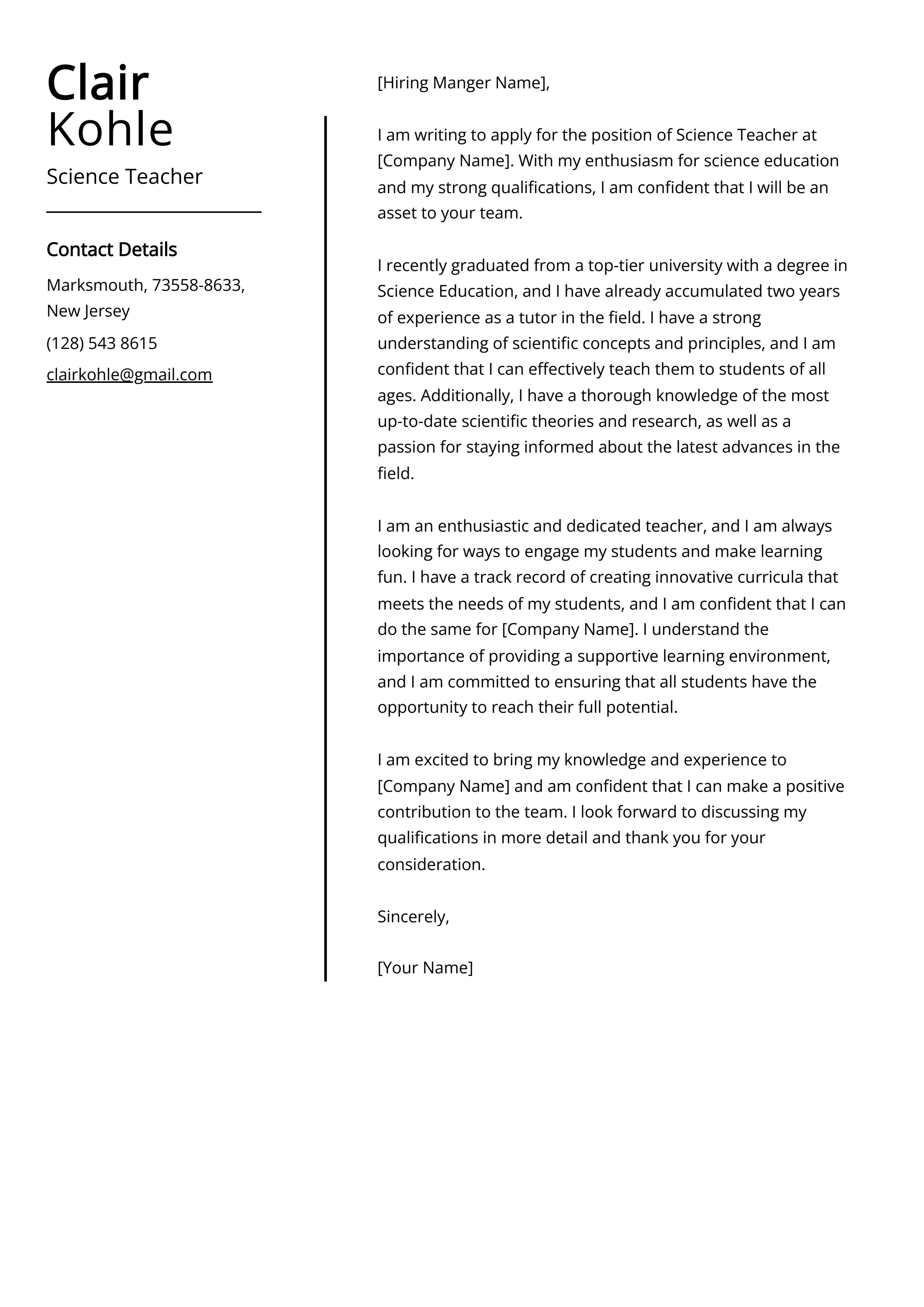
Format your cover letter for readability. Use a professional font like Times New Roman, Arial, or Calibri. Keep the font size at a readable level (e.g., 11 or 12 points). Use single spacing and a standard margin (1 inch). Use paragraphs that are concise and easy to follow. Use bullet points or numbered lists to highlight your skills or accomplishments. A well-formatted cover letter is easier to read and helps the hiring manager to quickly find the important information. Ensure that it’s easy on the eyes, making it easier for the hiring manager to engage.
Sample Cover Letter for Science Teachers
Here are a few examples to give you an idea of the cover letter structure and writing style for science teachers at various levels.
Example 1 for High School Science Teacher
Dear [Hiring Manager Name],
I am writing to express my keen interest in the High School Science Teacher position at [School Name], as advertised on [Platform]. With five years of experience teaching biology, chemistry, and physics, I am confident that my skills and passion for science education align perfectly with your school’s mission. In my previous role at [Previous School], I increased student engagement in science projects by 30% by introducing innovative, hands-on lab activities. I am proficient in curriculum development and have successfully implemented the NGSS standards in my classroom. I am excited about the opportunity to contribute to your team and am available for an interview at your earliest convenience. Thank you for your consideration.
Sincerely, [Your Name]
Example 2 for Middle School Science Teacher
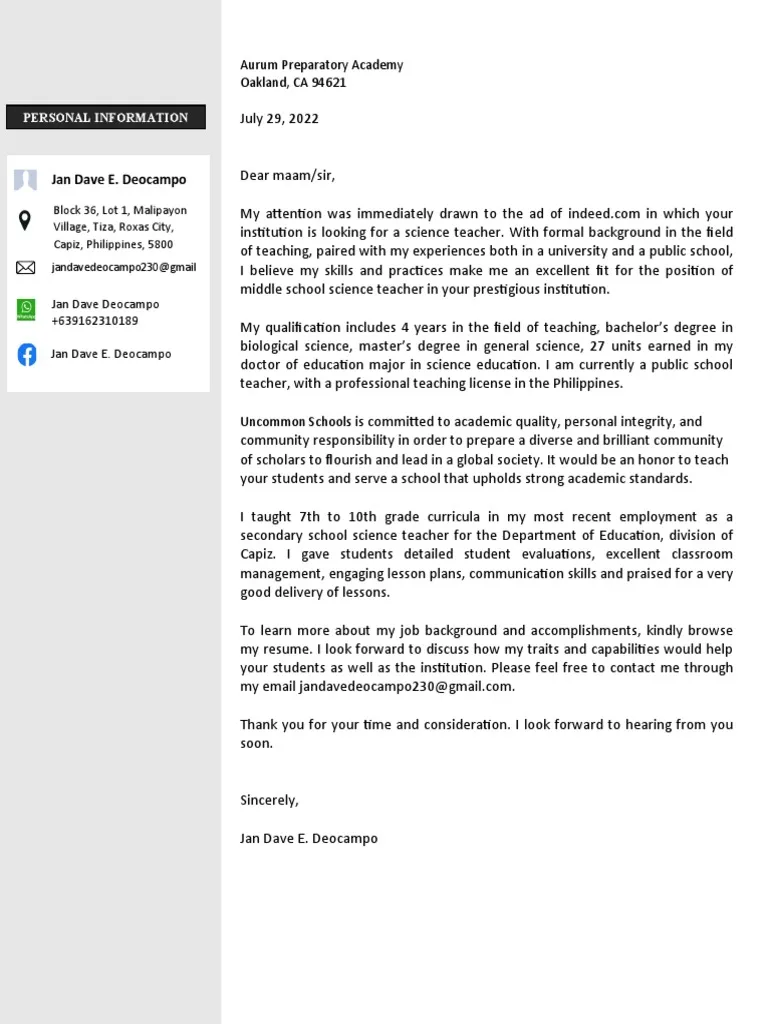
Dear [Hiring Manager Name],
I am thrilled to apply for the Middle School Science Teacher position at [School Name]. I am an enthusiastic educator committed to fostering a love for science in young minds. I have a strong background in teaching life science, physical science, and earth science. I am adept at creating engaging lesson plans, incorporating interactive learning methods, and managing a diverse classroom environment. I believe my passion for teaching and dedication to student success make me an ideal candidate. I am looking forward to discussing how I can contribute to your school. Thank you for your time.
Sincerely, [Your Name]
Key Takeaways from Cover Letter Success
Crafting a compelling cover letter is a vital step in securing a science teaching position. Focus on highlighting your experiences, showing your curriculum knowledge, and demonstrating your passion. Always tailor your letter to the specific school, and ensure that it is free of errors. By following these tips, you will increase your chances of getting hired. Remember to quantify achievements, emphasize relevant skills, and proofread carefully. A well-written cover letter is a powerful tool that can open doors to your teaching career. Embrace these strategies to create a compelling cover letter that helps you stand out and showcases you are the perfect candidate for the job.
